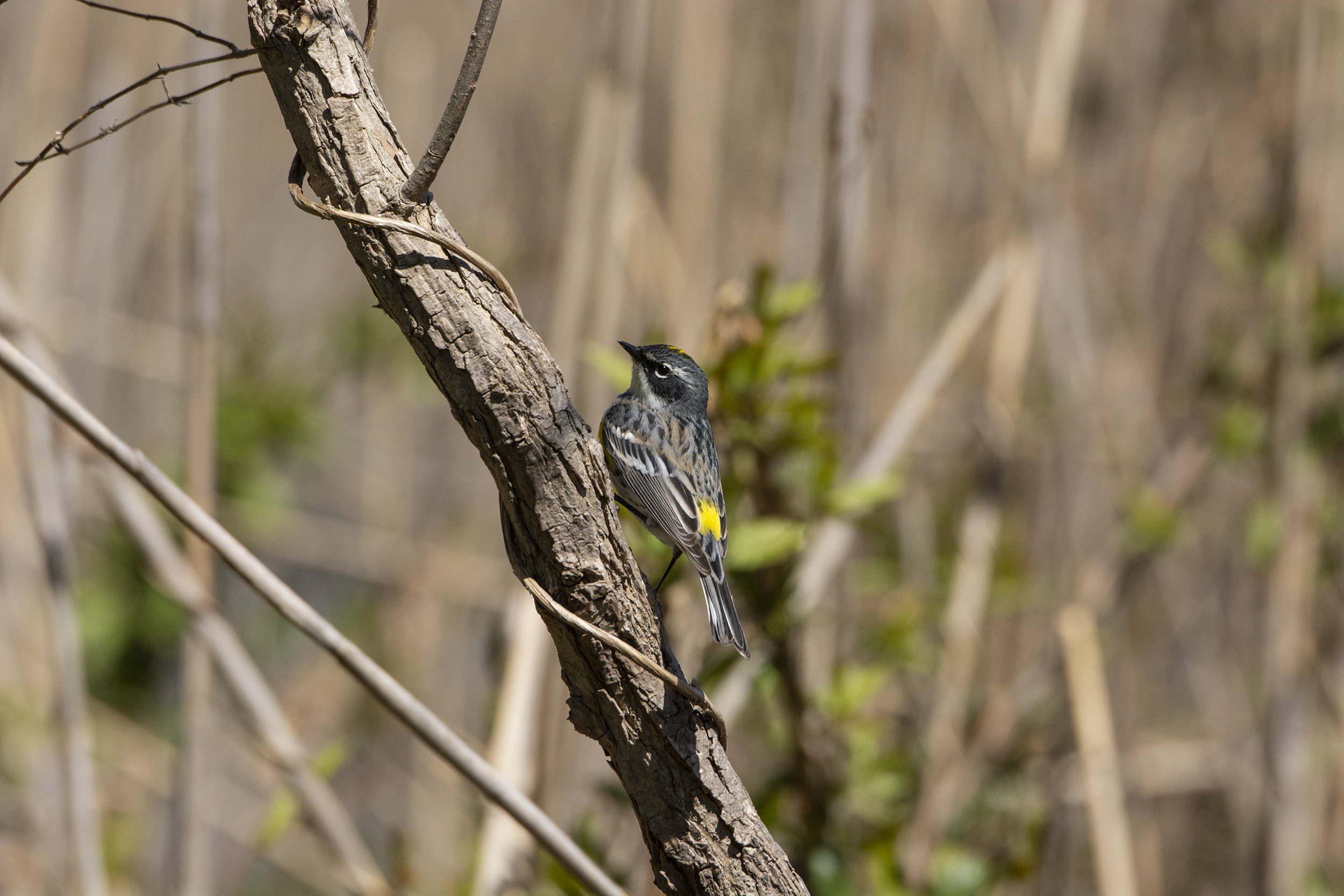Invasion of the Butter Butts

By John L. Turner
On an Indian summer kind of morning in mid-October, I decided to explore the Preserve owned by the Villageof Nissequogue at the end of Long Beach Road, on the north side of Stony Brook Harbor. I was hoping to see a lingering diamondback terrapin in the marshes fringing this side of the harbor.
As soon as I exited the car in the small parking lot, flanked by coastal plants, there was flittering movement all around - movement that I half expected given the time of year. The ceaseless motion was in the form of a dozen or so small birds and I knew I was witnessing the seasonal invasion of the “Butter-butts,” or as a friend calls them “budda-butts”! Whatever you call it, this species is formally known as a Yellow-rumped Warbler due to the conspicuous and distinctive bright yellow rump patch on the top side of the tail base. At any one time there were half-a-dozen birds flitting in the Red Cedar trees and Groundsel bushes, and one hovered over the top of a seaside goldenrod plant for several seconds, presumably attracted to small, late-season, nectar-seeking insects in the bright yellow flowers.
The Butter-butts were joined by half a dozen even smaller birds that flashed yellow too; not from the tail but from the top of the head. These were Golden-crowned kinglets, a species that competes for the title of North America’s smallest songbird (Hummingbirds are smaller, but are not songbirds). It is closely related to the Ruby-crowned Kinglet, another bird that breeds north of Long Island but passes through these parts during spring and fall migration. This invasion will last through the winter until next Spring, when the warblers and kinglets depart northward to their breeding grounds.
Yellow-rumped warblers are one of fifty-four colorful species of warblers found in North America, of which approximately three dozen occur in the eastern half of the country. This group of birds has often been referred to as the “butterflies of the bird world,” given their resplendent plumage patterns of orange, red, yellow, blue, and green colors. Their passing through Long Island during spring migration, when males are in their gaudy breeding plumages, is one of the highlights to a birder’s year.
Warblers, as a general rule, flood out of the middle and northern portions of North America, overwintering in South America, Central America, the Caribbean, and the southern United States. They do so because their food source - almost entirely insects - disappears with the cold weather. So to stay in cold climates would be to risk starvation. However, the Yellow-rumped is an exception and regularly overwinters throughout the United States. Why is this so you might reasonably ask? It’s due to the species’ unique ability to sustain itself by eating a type of food that other warblers and most other songbirds apparently do not or cannot - wax.
The wax is in the form of a waxy outer coating on berries and there are two plant species on Long Island that best fit the bill, producing large quantities of waxy fruits: Bayberry and Poison Ivy. Wax is difficult for birds to digest and only a couple of dozen species worldwide have become adept at capitalizing on this novel food source, including our Butter-butts. Scientists studying the phenomenon of wax digestion in Yellow-rumped warblers have found several traits that allow wax assimilation, including very slow digestive times with the wax broken down in the gizzard, high bile salt levels in their gall bladders to more effectively break down the wax into its fatty acid components, and, remarkably, the ability to move partially digested foods back into the gizzard from the intestines to further break down the wax (which partially explains the slow digestive times). It can take a small warbler upwards of four hours from when the wax berries are eaten until the digested remains are excreted. In contrast, songbirds eating sweet fruits in the Summer and early Fall can pass the material in as little as 20 minutes.
Further south in their winter range, from New Jersey southward, Yellow-rumps depend more upon Wax Myrtle, a close relative of Bayberry, that also has wax-covered fruits. The bird’s association with this plant is so strong that for many decades the Yellow-rumped Warbler was known as the Myrtle Warbler.
In the western United States, the Yellow-rumped Warbler is joined by its close associate, the Audubon’s Warbler, which looks very similar to the Yellow-rumped, except that it has a yellow throat patch while the Yellow-rumped has a white patch.
Golden-crowned Kinglets apparently do not eat waxy fruits and survive the winter eating dormant insects, their eggs, spiders, and oozing sap. If you pay close attention the males can be separated from the females - males have orange-tinged head crowns while females have yellow. This bright orange coloration is the reason why this species in Europe is not called a kinglet, although it’s the same species, but instead the rather descriptive “Firecrest”.
You can see Kinglets and Butter-butts until early Spring - then they both wing back north, throughout New England and across much of Canada, for the breeding season. Here they’ll raise their next generation of birds which will brighten our winter days with a little dash of yellowy sunshine a year from now.
Photos by Luke Ormand - All Rights Reserved, 2019






